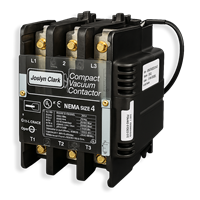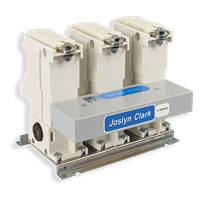Vacuum Contactors in High Altitude Environments
Working with motor control applications at high altitudes is difficult because the air becomes thinner as altitude increases. This means there are fewer molecules to dissipate heat, causing electrical equipment to wear out faster. In addition, the dielectric strength of the air decreases at higher altitudes, which can lead to potential flashover. That's why it's important to know how to specify vacuum contactors for high altitude environments.
It is best to separate the concept of altitude derating in vacuum contactors into two sections—first, power components, including terminals and vacuum interrupters. Second, the control which consists of the magnetic coils utilized to actuate the vacuum interrupters.
1. Power Components Derating
At higher altitudes, the air is weaker, which means there's a greater chance of flashover. Ensuring that electrical equipment is rated for the altitude where it will be used is important.
Thinner air reduces the ability of equipment to transfer heat effectively, requiring a derating of the operating current, although not to the same extent as BIL. Table A below shows the recommended derating by altitude for Joslyn Clark's Vacuum Contactors with 7.2kV, 3.6kV, and 1.5kV.
Note: All vacuum contactors are qualified for an altitude of 2000 meters. Current derating starts when altitude exceeds approximately 2000 meters. For further detail, please refer to our datasheets.
Table A. Vacuum Contactor Power Section De-Rating By Altitude
| Altitude (ft) | Altitude (m) | 7.2kV BIL (V) | 3.6kV BIL (V) | 1.5kV BIL (V) | ASNI/IEEE Dielectric Factor | Operating Current (A) | Operating Current De-Rating Factor |
| 3300 | 1000 | 60000 | 45000 | 30000 | 1.00 | 600 | 1.000 |
| 6000 | 2000 | 60000 | 45000 | 30000 | 1.00 | 600 | 1.000 |
| 10000 | 3000 | 48000 | 36000 | 24000 | 0.900 | 570 | 0.950 |
| 13000 | 4000 | 42000 | 31000 | 21000 | 0.800 | 555 | 0.925 |
| 16000 | 5000 | 36000 | 27000 | 18000 | 0.700 | 540 | 0.900 |
| 20000 | 6000 | 30000 | 23000 | 15000 | 0.600 | 525 | 0.875 |
2. Control Module Derating
The coils in the control module use a magnetic field to pull on a contact material. This makes the contactor work. The coil circuit has two states.
The first state uses the most electricity when the contact material is far apart (open state). When the contact material comes together (closed state), it activates a switch that uses less electricity. This keeps the coils from getting too hot when they're used a lot.
Thinner air at high altitudes causes coils to have less natural convective heat dissipation. In this case, premature failures from frequent cycling can occur. To avoid these premature failures, you will want to reduce the switching frequency of your contactor. For the recommended derating for Joslyn Clark's Vacuum Contactors, see Table B below.
Table B. Cycles/Hr Derating
| Altitude (ft) | Altitude (m) | Cycles / Hour |
| 3300 | 1000 | 300 |
| 6600 | 2000 | 300 |
| 10000 | 3000 | 225 |
| 13000 | 4000 | 150 |
| 16000 | 5000 | 100 |
| 20000 | 6000 | 50 |
Vacuum contactors use the vacuum inside them to help close the contacts. As the air gets thinner outside the contactor, the vacuum's force inside it to help close the contacts also decreases. This means that the contactor needs to be adjusted to work properly at different altitudes.
When the air pressure is lower at higher altitudes, the contacts will open faster than at sea level. However, this doesn't make a big difference. Table C shows how altitude affects the pick-up and drop-out voltages of a vacuum contactor.
Table C. Pickup and Drop Out Derating
| Altitude (ft) | Altitude (m) | Rick-Up Rated Voltage | Drop-out Rated Voltage |
| 3300 | 1000 | 85% | 70% |
| 6600 | 2000 | 85% | 70% |
| 10000 | 3000 | 86% | 72% |
| 13000 | 4000 | 87% | 74% |
| 16000 | 5000 | 88% | 76% |
| 20000 | 6000 | 89% | 78% |
Frequently Asked Questions:
Q: What are vacuum contactors suitable for?
Vacuum contactors are effective for high-endurance and high-capacity applications, like starting and controlling motors and correcting power factor. They're especially helpful in harsh environments because they're dependable and last longer than air contactors. Vacuum contactors are necessary for efficient and dependable motor control in electrical panels and play a crucial role in many industrial applications.
Q: What is the difference between a vacuum contactor and an air contactor?
Vacuum contactors and air contactors differ in the material they use to isolate contacts. Air contactors use air, while vacuum contactors use a vacuum.
Vacuum contactors have many benefits over air contactors, including being more durable, having higher switching capacity, lasting longer, and working better in tough environments. They're also smaller and less likely to cause an arc flash. Even though air contactors are cheaper, they're less trustworthy and require more maintenance.
Q: What is the difference between a vacuum contactor and a vacuum circuit breaker?
In high-voltage and high-endurance applications, a vacuum contactor functions as a switch, whereas a vacuum circuit breaker is intended for high-voltage power distribution systems. The key distinction between the two is their purpose. Vacuum contactors turn electrical power on and off, while vacuum circuit breakers halt the flow of electrical power in the event of an issue.
Another difference is that vacuum circuit breakers are usually for higher voltage situations than vacuum contactors. Even though both use vacuum technology to isolate the contacts and work reliably, they have different purposes and applications.
Q: What is the purpose of vacuum contactors in electrical panel?
Vacuum contactors are a necessary part of electrical panels that efficiently and dependably control and start motors. They switch electrical power on and off and are ideal for high-endurance and high-capacity applications.
Vacuum contactors are particularly useful in harsh environments because they last longer and are more reliable than air contactors. They're also safer, smaller, and less likely to cause an arc flash. Industrial settings that use electrical systems with vacuum contactors include manufacturing, power generation, and transportation. All in all, vacuum contactors are important for the dependable and safe operation of industrial electrical systems.
What are switching transients and how to minimize them with vacuum contactors
Vacuum contactor mounting best practices
CV Series Compact Vacuum Contactor
Joslyn Clark’s Compact CV Series Vacuum Contactors and Starters are ideal for tough industrial applications. The compact design provides flexibility for retrofitting air break contactors, thus enabling an existing application to continue with maintenance cost and down time eliminated. Voltage raging from 600V to 1500KV and current ratings up to 600A are available.Learn more »
MVC Series Medium Voltage Vacuum Contactor
The Joslyn Clark USAVAC medium voltage vacuum contactors are 3-phase motor contactors built for control and protection in medium voltage applications ranging from 2300V to 7200V. Current ratings of 200-1200 ampere, and motor ratings up to 7000 HP at 6600V are available.Learn more »




